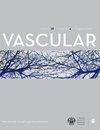逆行开放式肠系膜支架植入术与急性肠系膜缺血的治疗效果。
摘要
目的:有关逆行开放式肠系膜支架置入术(ROMS)治疗紧急肠系膜缺血的数据仅限于小型单中心和病例系列,不同患者的使用情况各不相同,且结果不明确。我们旨在评估需要紧急手术干预的急性肠系膜缺血患者的特征和预后:从全国住院患者样本(NIS)数据库中查询了2018年至2020年需要紧急手术干预的肠系膜缺血患者的回顾性队列研究。研究组被定义为需要开放式搭桥术(BYPASS)、开放式肠系膜上动脉栓塞切除术(OPEN)或ROMS的患者。描述性统计用于报告变量。使用t检验、卡方检验和多变量回归进行比较,并酌情以几率比(OR)和95%置信区间(CI)进行报告:共纳入 898 例肠系膜缺血并需要紧急手术治疗的患者:旁路手术:284例;开放手术:363例;ROMS手术:251例。两组患者在性别和种族上没有差异。需要 ROMS 的患者年龄更大的可能性为 70.2 + 11.3,而搭桥患者为 66.81 + 11.6,开放患者为 67.17 + 14.5,P = 0.0035。ROMS 患者的夏尔森合并症指数(CCI)最高,分别为 2.9 和 2.5,Bypass 和 OPEN 为 2.6,p = 0.0292:糖尿病 37% (p = 0.01)、肾病 24.3% (p = 0.5)、术前曾发生心肌梗死 9.2% (p = 0.05);然而,本组死亡率最低,为 15.9%,搭桥组为 19.7%,开放组为 34.5%,p < 0.0001。需要搭桥的患者更有可能患有慢性肺部疾病(34.5%,OPEN 24.2%,ROMS 31.5%,P = 0.013)、外周血管疾病(PVD)(38%,OPEN 16%,ROMS 29.9%,P < 0.0001)。多变量回归结果显示,ROMS 与死亡率降低 50% 相关(OR 0.45,95% CI 0.27-0.75)。与旁路手术相比,开放式SMA栓子切除术与近2倍的死亡率相关,OR为2.0,95% CI为1.3-3.0,P < 0.001。既往心肌梗死也与近两倍的死亡率相关(OR 1.9,95% CI 1.01-3.6),而既往心血管病具有保护作用(OR 0.56,95% CI 0.36-0.89)。较高的CCI和年龄与死亡率风险略有增加有关,OR值分别为1.2和1.03,两者的P<0.05:结论:对于急性肠系膜缺血患者,与传统的开放手术相比,ROMS具有显著的死亡率优势。高龄、心肌梗死病史和开放式 SMA 栓塞切除术与死亡率升高有关。在真实世界人群中评估 ROMS 的数据很少,而 ROMS 是一种较新的技术。这些数据表明,在急性期恢复肠系膜血流时,ROMS可能是一种更好的选择,因此需要进一步开展前瞻性研究,评估ROMS与其他手术类型在急诊和择期手术中的效果。ObjectivesData regarding retrograde open mesenteric stenting (ROMS) for urgent mesenteric ischemia is limited to small single center and case series, with variable utilization across patient populations and ill-defined outcomes. We aimed to evaluate characteristics and outcomes of patients with acute mesenteric ischemia requiring urgent surgical intervention.MethodsRetrospective cohort study of patients with mesenteric ischemia requiring urgent surgical intervention from 2018 to 2020 was queried from the National Inpatient Sample (NIS) database. Study groups were defined as those requiring an open bypass (BYPASS), an open superior mesenteric artery embolectomy (OPEN), or ROMS. Descriptive statistics were used to report variables. Comparisons were mad using t test, chi-squares tests, and multivariate regression reported as odds ratio (OR), 95% confidence interval (CI) where appropriate.Results898 patients with mesenteric ischemia requiring urgent surgical intervention were included: Bypass: 284, OPEN: 363, ROMS: 251. There was no difference in gender or race between groups. Patients requiring ROMS were more likely to be older 70.2 + 11.3versus Bypass 66.81 + 11.6 and OPEN 67.17 + 14.5, p = 0.0035. ROMS patients had the highest Charlson Comorbidity Index (CCI) 2.9 versus 2.5 Bypass and 2.6 OPEN, p = 0.0292 with the most frequent comorbidities: Diabetes 37% (p = 0.01), renal disease 24.3% (p = 0.5), and previous preoperative myocardial infarction 9.2%, p = 0.05; however, the lowest mortality rate was seen within this Group 15.9% versus bypass 19.7%, OPEN 34.5%, p < 0.0001. Patients requiring bypass were more likely to have chronic pulmonary disease 34.5% versus OPEN 24.2% and ROMS 31.5%, p = 0.013, peripheral vascular disease (PVD) 38% versus OPEN 16%, and ROMS 29.9%, p < 0.0001. On multivariate regression, ROMS was associated with 50% decreased incidence of mortality (OR 0.45, 95% CI 0.27-0.75). Open SMA embolectomy was associated with nearly 2x mortality rate compared to bypass procedures OR 2.0, 95% CI 1.3-3.0, p < 0.001. Previous MI was also associated with nearly 2x incidence of mortality (OR 1.9, 95% CI 1.01-3.6), while pre-existing PVD conferred a protective effect (OR 0.56, 95% CI 0.36-0.89). Higher CCI and age were associated with slightly increased risk for mortality OR 1.2 and 1.03, p < 0.05 for both.ConclusionsIn patients with acute mesenteric ischemia, ROMS demonstrated a significant mortality benefit compared to traditional open procedures. Advanced age, history of MI, and open SMA embolectomy were associated with increased mortality. Little data exists regarding ROMS in a real-world population evaluating ROMS, which is a newer technique. These data suggest that ROMS may be a superior alternative to restore mesenteric flow in the acute setting and further prospective studies evaluating ROMS to other procedural types in urgent and elective settings are needed.

 求助内容:
求助内容: 应助结果提醒方式:
应助结果提醒方式:


